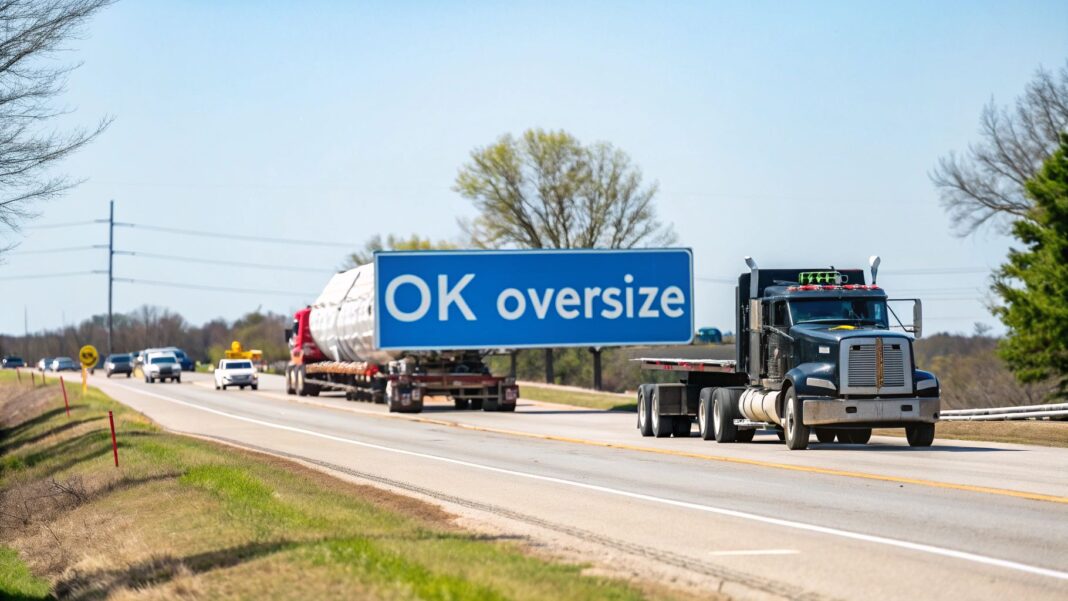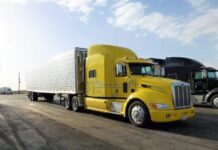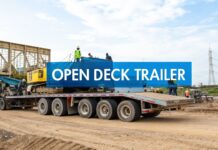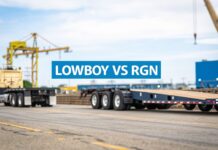
When hauling an oversized load through Oklahoma, you must navigate a specific set of rules from the Oklahoma Department of Public Safety (DPS). If your cargo exceeds standard legal limits in size or weight, securing a special permit before transit is mandatory. This guide provides actionable instructions to ensure you remain compliant with all OK oversize regulations.
Your First Steps with Oklahoma Oversize Rules
Compliance with Oklahoma’s oversize regulations is the first step to a successful haul. Proper planning and paperwork are essential to avoid expensive fines, dangerous situations, and frustrating delays. This is not just about avoiding a ticket—it's about ensuring the safety of your driver, your cargo, and the public.
Your journey starts with one critical question: is my load "oversize" or "overweight"? Knowing the exact legal thresholds is your most important first step. Before applying for a permit or planning a route, you must have accurate measurements, as these numbers will dictate every subsequent action.
Key Starting Points for Haulers
To begin the process correctly, you need to confirm these key details:
- Accurate Measurements: Use a tape measure and certified scales to get the precise width, height, length, and gross vehicle weight of your loaded truck. A small miscalculation can result in the wrong permit type, leading to a major violation at a weigh station.
- Identify Your Load Category: Determine if your load is oversize, overweight, or a combination of both. Each category has its own specific set of regulations, permit requirements, and travel restrictions.
- Understand the Permit System: Familiarize yourself with the Oklahoma DPS permitting portal before you need to use it. Knowing what information is required in advance will streamline the application process.
A common mistake is rushing through initial planning. A successful haul is built on a foundation of accurate data and a clear understanding of state regulations.
This foundational knowledge is crucial for anyone involved in transporting oversized loads. Once you've mastered these basics, you'll be prepared to manage the more complex aspects of Oklahoma's regulations, such as pilot car requirements and specific route restrictions.
What Counts as an Oversize Load in Oklahoma?

Before route planning or filling out permit applications, you must determine if your shipment qualifies as "oversize." Oklahoma defines a standard "box" of legal dimensions for commercial vehicles. If your truck and cargo exceed any of these limits, you have entered oversize territory and must obtain a permit.
Exceeding just one of these legal thresholds means you are subject to a different set of rules and must comply with all OK oversize regulations. A single inch can be the difference between a routine haul and a complex project requiring special permits, escorts, and route surveys. These dimensions are set to ensure that large loads can safely navigate public roads, bridges, and overpasses.
Key Dimension Thresholds
Here are the specific dimensions that trigger the need for an oversize permit in Oklahoma:
The most common trigger is width. If your load is wider than 8 feet 6 inches (102 inches), a permit is required. This is a national standard designed to keep vehicles within their designated traffic lane.
Next is height. In Oklahoma, the legal height limit is 13 feet 6 inches. Any load taller than this requires a permit and a carefully planned route to avoid low-clearance bridges and overpasses.
Length requirements are specific to the vehicle's configuration:
- Single Vehicle: A straight truck has a maximum length of 45 feet.
- Truck-Tractor and Semitrailer: The trailer itself cannot exceed 53 feet.
- Combinations (Doubles/Triples): The total combination length is generally limited to 65 feet.
Understanding Gross Weight Limits
Dimensions are only one part of the equation; weight is the final critical factor. For a standard five-axle combination, the gross vehicle weight limit in Oklahoma is 80,000 pounds. If your total weight exceeds this limit—even with legal dimensions—you are considered overweight and must obtain an overweight permit.
The rule is simple: if you exceed any single legal limit for width, height, length, or weight, you must have the correct Oklahoma permit before your trip begins.
While regulations vary by state, these general thresholds are common across the U.S. For a broader perspective, you can review the federal overview of current size and weight regulations. Understanding these basics is the first step to successfully navigating the permit and escort process.
Getting Your Oklahoma Oversize Permit

For any oversize transport in Oklahoma, the permit is your legal authorization to travel. The Oklahoma Department of Public Safety (DPS) offers an online portal, but a successful application requires thorough preparation.
Before logging in, gather all necessary documentation and data. Precision is key; estimates are not accepted. You must have the final, verified dimensions and weight of your fully loaded vehicle.
Your Pre-Application Checklist
To avoid application rejection and costly delays, compile the following information beforehand:
- Vehicle Specs: The truck’s VIN, license plate number, and detailed axle information, including the number of axles, their spacing, and the weight distribution on each.
- Exact Load Dimensions: The final loaded width, height, and overall length measured from the front bumper to the rearmost point of the cargo.
- Total Gross Weight: The combined weight of the truck, trailer, and the cargo.
- Your Planned Route: A detailed map of your entire journey, specifying every state highway and interstate you intend to use from entry to exit of Oklahoma.
Having this information verified and ready is the most effective way to ensure your application is approved promptly. Simple errors, like a typo in a highway number or an incorrect dimension, are the primary reasons for permit delays.
The permit application is more than paperwork—it's a safety blueprint. The state uses your route and dimension data to verify that your load can safely navigate every bridge, underpass, and interchange on your path.
Picking the Right Permit for the Job
Oklahoma offers several permit types. Selecting the correct one can save significant time and money, depending on the frequency and nature of your hauls.
The three main permit types are:
- Single-Trip Permits: Valid for one specific move along a pre-approved route. This is the standard choice for one-off jobs or infrequent travel through Oklahoma.
- Multi-Trip Permits: A practical option for moving several similar loads over a short period. This permit covers multiple trips, but they must all follow the same approved route.
- Annual Permits: An efficient solution for businesses that frequently move oversize loads in Oklahoma. It provides coverage for an entire year but has specific limitations on maximum size and weight.
Understanding the differences between these permits is essential for managing logistics costs. For a broader look at how states manage these documents, our guide on oversize transport permits provides valuable insights for your planning.
Oklahoma's Pilot Car and Escort Requirements
Determining if your load requires a pilot car is a critical step in your transport plan. An escort vehicle functions as a mobile safety buffer for your cargo, your driver, and other motorists. Oklahoma's escort regulations are tiered: as your load's dimensions increase, so do the mandatory support requirements.
Failure to secure the proper escorts is a serious violation of OK oversize regulations and will result in your shipment being shut down immediately. These rules are in place to manage traffic, warn other drivers, and ensure your load can safely clear bridges and navigate turns.
When Are Escorts Mandatory?
Oklahoma’s requirements are directly tied to your load’s dimensions. The triggers for needing one or more escorts are clear and non-negotiable.
The initial triggers are:
- Any load over 12 feet wide requires one front escort on all highways.
- Any load over 80 feet long requires one rear escort on two-lane highways.
It is common for a single load to meet multiple criteria. For example, cargo that is both wide and long will require both a front and a rear escort to be compliant. Safety is the top priority; you can learn more about how to reduce road accidents when transporting oversize vehicles with a few expert strategies.
This image shows how route planning, escort needs, and other transport restrictions are interconnected.

As shown, escort requirements are a fundamental component of route approval, just as crucial as road restrictions and travel time windows.
When Two Escorts or Police Are Needed
Once a load exceeds certain dimensions, the state mandates additional support. This reflects the increased risk of moving exceptionally large loads, which require a higher level of traffic control and coordination.
A second escort is required in these situations:
- Width: Loads over 14 feet wide on a two-lane road or over 16 feet wide on a multi-lane highway need both a front and a rear escort.
- Length: Loads exceeding 100 feet long on a two-lane highway require two escorts.
- Height: Loads taller than 15 feet 8 inches require two escorts. For these "high pole" loads, you must also contact all utility companies and railroads along your route before the move to arrange for line clearance.
For a quick reference, here is a summary of the escort requirements based on your load's dimensions.
Oklahoma Escort Requirements Based on Load Dimensions
| Load Dimension (Width/Length/Height) | Required Escort(s) |
|---|---|
| Over 12' wide | 1 Front Escort |
| Over 80' long (on 2-lane highways) | 1 Rear Escort |
| Over 14' wide (on 2-lane highways) | 1 Front & 1 Rear Escort |
| Over 16' wide (on multi-lane highways) | 1 Front & 1 Rear Escort |
| Over 100' long (on 2-lane highways) | 2 Escorts |
| Over 15' 8" high | 2 Escorts (plus utility/railroad coordination) |
This table simplifies the rules, but always be aware that the state may impose additional requirements for unusually complex loads.
The most extreme loads—those that are exceptionally wide or heavy and may require road closures—often need a police escort. This is not something you arrange yourself; the state will mandate it during the permit review if it is deemed necessary for public safety.
Pilot Car Operator and Vehicle Requirements
Oklahoma regulates not just when an escort is needed, but also the vehicles and operators themselves. An escort vehicle must be a passenger car or a pickup truck with at least a quarter-ton capacity.
All pilot vehicles must display an "OVERSIZE LOAD" sign, be equipped with amber warning lights visible from 500 feet, and carry specific safety equipment. This includes a two-way radio, a fire extinguisher, and traffic control paddles, ensuring they are prepared for any situation on the road.
Navigating Oklahoma's Travel and Time Restrictions

Obtaining a permit is a major step, but it doesn't authorize immediate travel. In Oklahoma, when you can travel is as critical as the permit itself. The state enforces these time restrictions to ensure oversized loads move during periods of optimal visibility and lower traffic volume, enhancing safety for everyone.
The primary rule is that travel is permitted only during daylight hours, defined as from 30 minutes before sunrise to 30 minutes after sunset. Driving outside this window is a serious violation that can result in your vehicle being parked and significant fines.
In addition to the daily schedule, you must plan for weekend restrictions. Travel is permitted from Monday morning until noon on Saturday. After this time, you must find a safe and legal location to park until Monday morning. This weekend shutdown is a critical factor for logistics planning.
Dealing with Big City Curfews
If your route passes through Oklahoma City or Tulsa, you must adhere to strict curfews designed to prevent oversized loads from causing congestion during peak traffic hours.
- Oklahoma City: No travel is allowed from 7:00 AM to 9:00 AM or from 3:00 PM to 6:00 PM on weekdays.
- Tulsa: Similar restrictions apply, with a travel ban from 7:00 AM to 9:00 AM and from 4:00 PM to 6:00 PM on weekdays.
Miscalculating your arrival by even a few minutes can disrupt your entire schedule. Arriving at the city limits as a curfew begins will force you to wait until it lifts, costing time and money.
Holiday Travel Blackouts
During major holidays, when public traffic increases, oversized loads are prohibited from traveling. Plan for complete shutdowns on these days:
- New Year's Day
- Memorial Day
- Independence Day
- Labor Day
- Thanksgiving Day
- Christmas Day
The travel ban typically begins at noon on the day before the holiday and ends at sunrise on the day after. Always verify the specific restriction dates on your permit, as the times can vary slightly each year.
A Quick Look at Permit Fees
Understanding your costs is essential for a successful haul. Oklahoma's permit fees are generally straightforward. A standard single-trip permit for an oversized or overweight load typically costs $40.
Additional fees may apply for exceptionally large loads or more specialized permits. For companies that haul frequently in Oklahoma, an annual permit may offer better value but has its own fee schedule.
The best practice is to always confirm current fees with the Oklahoma Department of Public Safety during your application. This quick step prevents financial surprises and keeps your transport budget accurate.
Mandatory Signage and Lighting for Your Load
https://www.youtube.com/embed/_sQNz2liUuY
Properly marking your truck and cargo with signs, flags, and lights is a universal safety language on the highway. When hauling an oversize load in Oklahoma, these markings are not just a regulatory requirement—they are a critical communication tool for alerting other drivers and preventing accidents.
The most important marking is the "OVERSIZE LOAD" banner. Oklahoma has specific regulations for these banners: they must be yellow with black letters, at least five feet long and one foot high. One banner must be securely mounted on the front of the truck and another at the rear of the load, ensuring visibility from both directions.
Marking Your Load's Extremities
After placing the banners, you must mark the widest points of your cargo. Bright red or fluorescent orange warning flags are required for this purpose.
- Flag Dimensions: Each flag must be at least 12 inches by 12 inches.
- Placement: Attach one flag to each of the four corners of the load. If any part of the cargo extends beyond the trailer's sides, place the flags on those outermost points.
These flags serve as visual guides for other drivers, helping them accurately gauge your vehicle's width and provide adequate space.
Properly marking a load is one of the most effective and straightforward ways to prevent sideswipes and other common accidents. It is a pre-trip check that is essential for safety and compliance.
Essential Lighting Requirements
Warning lights are as crucial as signs and flags and are required on both the power unit and any pilot cars. The truck must be equipped with a rotating or flashing amber beacon on top of the cab, visible from at least 500 feet in all directions.
This light is mandatory and must be activated whenever the oversize load is in motion on a public road.
These safety standards are based on universal principles seen worldwide. The European Union, for example, uses Directive 96/53/EC for oversize transport and digital tachographs under Regulation (EU) No 165/2014 to monitor driver hours. These regulations are part of a global effort to enhance transport safety on public roads.
Answering Your Top Oklahoma Hauling Questions
When moving a large load through Oklahoma, specific questions often arise that require immediate and accurate answers. Here are clarifications for some of the most common inquiries from haulers.
How Long Does It Take to Get a Permit?
Oklahoma’s online system is efficient for standard requests. For a straightforward single-trip application with accurate information, approval can often be granted within a few hours to one business day.
However, do not wait until the last minute. For complex loads—such as superloads, non-standard routes, or shipments requiring special review—allow for a longer processing time. Plan to submit your application at least 3 to 5 business days in advance.
Can I Haul an Oversize Load at Night?
No. Night travel is strictly prohibited for oversize loads in Oklahoma.
Your travel window is limited to daylight hours, defined as 30 minutes before sunrise to 30 minutes after sunset. This rule applies from Monday morning through noon on Saturday. Remember that travel is also suspended on major holidays, so always confirm the exact dates and times listed on your permit before departure.
"What happens if my load is bigger than what my permit says?" This is a frequent and critical question. The consequences are severe, highlighting the need for absolute precision in your initial measurements.
If you are stopped for an inspection and your load's dimensions or weight exceed what is stated on your permit, your vehicle will be placed out of service immediately.
This results in significant fines and a complete halt to your journey. Your load will not be permitted to move until you have secured a new, corrected permit. This costly and time-consuming mistake underscores the importance of verifying every measurement before submitting your application.
Planning a complex haul requires more than just a truck and a driver; it demands expertise and meticulous attention to detail. The team at We Will Transport It specializes in managing every aspect of your oversized shipment. We handle everything from securing the correct permits to coordinating on-the-ground logistics, ensuring your cargo arrives at its destination safely and on schedule. Learn more about our heavy equipment and oversize transport services.







